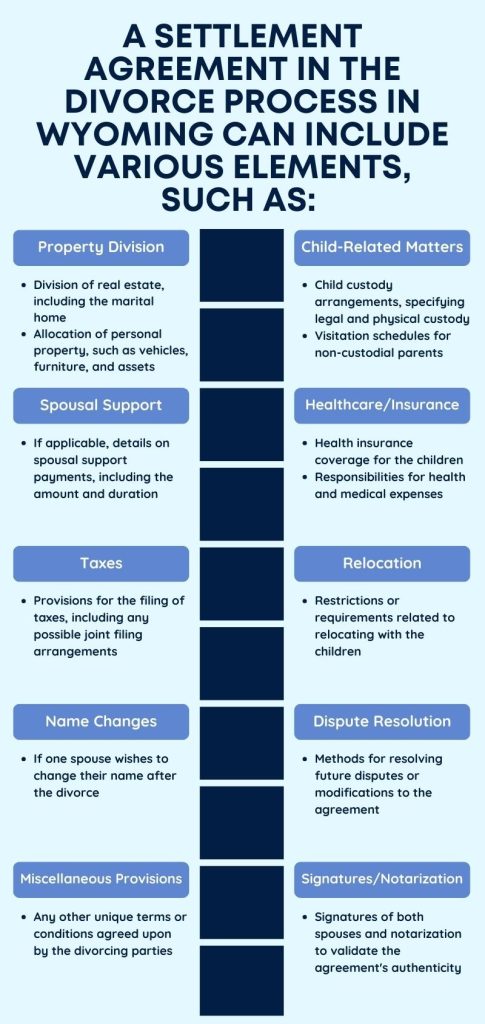Many couples who wish to end their marriage consider getting a divorce in Wyoming without a lawyer. Nevertheless, they might need some guidance to be sure that everything is done properly, and they will not need to start the entire process afresh, wasting time and money.
The procedure of filing for divorce in Wyoming generally consists of submitting the complaint to the court, serving the documents on the respondent, and getting your divorce decree signed by the judge. Your marriage can be dissolved quite quickly and easily, especially if you and your spouse can cooperate amicably and agree on all the issues that need to be settled. However, you should make sure that you gather the necessary papers and complete the paperwork attentively, filling in all the forms properly and accurately.
In this article, we offer a comprehensive guide on the basic steps to file for divorce in Wyoming. We will try to explain what requirements you should meet and what papers and information you should gather and provide to the court. You will also get to know how long it may take and what exactly is required of you and your spouse in the process.
Step 1: Meet Residency Requirements

To start with, you should make sure that you meet the residency requirement for divorce. According to divorce laws in Wyoming, either both or at least one of the spouses must have lived in the state for a minimum of 60 days prior to filing a petition. You can file for divorce in the county where either of you resides.
Step 2: Gather Necessary Divorce Papers
One of the most important steps in the process would be finding and filling in the necessary divorce forms. Their number and type usually vary depending on each individual case. However, there is a basic set of divorce papers that will most probably include:
- Complaint for Divorce;
- Civil Cover Sheet;
- Vital Statistics form;
- Summons;
- Acknowledgement and Acceptance of Service;
- Affidavit for Divorce Without Appearance of Parties;
- Decree of Divorce.
If you divorce with children younger than 18 years, you may also need to provide the following forms:
- Confidential Statement of the Parties for Child Support Order;
- Confidential Financial Affidavit;
- Order for Income Withholding;
- Income Withholding for Support.
Generally, the set of papers that you should gather depends on the specific situation in your family and the agreements between you and your spouse. If you cannot agree on one or several disputes, you will need to hire an attorney who will guide you through the entire process and prepare the necessary documents for you. If your case is uncontested, and you have no disputes to resolve with your spouse, you may try finding the right forms yourself or get them at our paperwork preparation service. WYDivorceLaws can provide you with the right set of Wyoming divorce papers filled out based on your answers to our online questionnaires.
Step 3: Prepare the Complaint for Divorce

Complaint for Divorce is a document filed with the court requesting marriage termination. It is the very first form required in a Wyoming divorce process that covers all the basic information pertaining to the case. In it, you must specify all or some of the following details:
- Names of both the petitioner (the filing spouse) and the defendant (the other spouse);
- Both spouses’ residency;
- Date and location of the marriage;
- Date of separation;
- Names, birth dates, and residency of minor children (if any);
- Grounds for divorce;
- Initial requests for settlements of the disputes;
- Petitioner’s contact information.
If you have minor children, you will need the Complaint for Divorce specifically for spouses with kids, as this form will have a number of questions concerning children-related aspects of your marriage dissolution.
Step 4: File the Paperwork
To start the divorce, you need to visit the Clerk of the District Court in the county where either of the spouses resides and file the following forms:
- Complaint for Divorce;
- Civil Cover Sheet
- Vital Statistics form;
- Summons.
Depending on your case, there may be more forms to file. You will also need to pay a filing fee, which will vary depending on the county. The original documents will be left for the clerk, who will file-stamp the copies and give them back to you.

Step 5: Serve the Divorce Papers
After the paperwork is filed, the petitioner should officially notify the defendant about the divorce by serving them with the documents. It is important to note that the petitioner has 90 days from the date of filing the complaint to do this. If they miss the deadline, the case will be dismissed.
The easiest way to serve the papers is to give them to your spouse personally. Such a scenario may be possible if you are in a full-agreement case and are therefore sure that they will agree to accept the service. In this case, you will need to complete the Acknowledgement and Acceptance of Service form, while your spouse will have to sign and notarize it. You will then have to file it to confirm that they were served with divorce papers. In other cases, courts recommend using the Service by Sheriff option in the county where your spouse lives.
Step 6: Wait for Respondent’s Response

Normally, the defendant has 20 days to respond by agreeing or disagreeing with the provisions in the complaint or filing a counterclaim. In case they live in another state, this period will last 30 days. If no response is provided during this time, the petitioner may get a default divorce.
Step 7: Complete the Waiting Period
The waiting period for divorce in Wyoming is 20 days. It is imposed by the court to give couples a chance to change their mind and stop the marriage dissolution process. On the other hand, it is the time during which the spouses may negotiate the disputes if they have not yet been resolved. However, it does not mean that the judge will sign the Decree after this period is over. Depending on the number and nature of disputes, as well as the time you will need to resolve them, the entire divorce process may last much longer than that.
Step 8: Complete Financial Disclosures

Within 30 days after the respondent’s answer is served, spouses should complete initial financial disclosures by exchanging documents that contain a summary of all their assets and liabilities. It is extremely important to present downright truthful data without hiding anything. Therefore, make sure to disclose detailed information about all the financial and non-financial assets, individual and joint debts and marital property, safety deposit boxes, retirement accounts, employment, monthly income and expenses, etc. Initial disclosures should not be filed with the clerk unless specifically requested by the court; they are only meant for spouses to exchange.
Step 9: Reach and File a Settlement Agreement If Necessary

During the waiting period, the couple may negotiate and reach a specific divorce settlement agreement. It details the terms concerning the issues that may not be covered in the main forms and will be used by the judge in the final decision. If the court requires a hearing before making the judgment, you may be asked to answer a few questions about the grounds for this or that settlement.
Sometimes, an official separate document, the Divorce Settlement Agreement, may also be required. It normally defines all the terms and conditions regarding the division of property and assets, allocation of debts and liabilities, and issues regarding child custody and/or support, parenting time, alimony, etc. However, it is mostly common for contested divorce cases and must be drafted by a lawyer.
Step 10: Finalize the Divorce
To finalize your divorce, file the Decree of Divorce along with a few other final documents with the clerk. If the judge approves all the terms provided, they will sign the Decree. Normally, there is no need to be present at court hearings in case of an uncontested divorce. Nevertheless, sometimes, a couple may be invited to the courtroom for a very brief hearing to confirm their residency or grounds for divorce or to explain some of the terms in their agreements, for example. You get your divorce finalized as soon as the judge approves the Decree and it is filed with the clerk.


Martha Vineyard, an accomplished family law expert, boasts an extensive track record of navigating the intricate web of familial legal matters. Beyond her legal pursuits, Martha finds solace in the written word, crafting compelling narratives that shed light on the nuances related to this area. When not immersed in legal tomes, Martha enjoys her downtime with a passion for exploring new cuisines and sharing culinary adventures with loved ones.



